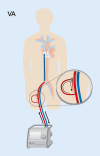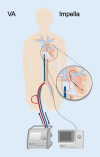ECMO in cardiac arrest and cardiogenic shock
- PMID: 28127638
- PMCID: PMC5306351
- DOI: 10.1007/s00059-016-4523-4
ECMO in cardiac arrest and cardiogenic shock
Abstract
Cardiogenic shock is an acute emergency, which is classically managed by medical support with inotropes or vasopressors and frequently requires invasive ventilation. However, both catecholamines and ventilation are associated with a worse prognosis, and many patients deteriorate despite all efforts. Mechanical circulatory support is increasingly considered to allow for recovery or to bridge until making a decision or definite treatment. Of all devices, extracorporeal membrane oxygenation (ECMO) is the most widely used. Here we review features and strategical considerations for the use of ECMO in cardiogenic shock and cardiac arrest.
Der kardiogene Schock ist ein akut lebensbedrohlicher Notfall, der klassischerweise medikamentös (u. a. Inotropika und ggf. Vasopressoren) behandelt wird und häufig eine invasive Beatmung erfordert. Katecholamine und Beatmung sind jedoch mit einer ungünstigen Prognose assoziiert, und viele Patienten sind mit konservativen Maßnahmen nicht zu stabilisieren. Mechanische Kreislaufunterstützung wird immer öfter herangezogen, um den Kreislauf zu stabilisieren, dem erkrankten Herzen Zeit zur Erholung zu verschaffen oder eine Überbrückung bis zur definitiven Therapie zu etablieren. Das aktuell weltweit am häufigsten eingesetzte System zur mechanischen Kreislaufunterstützung in diesem Zusammenhang ist die extrakorporale Membranoxygenierung (ECMO). In der vorliegenden Übersicht fassen die Autoren die speziellen Eigenschaften dieses Systems sowie strategische Überlegungen im Kontext des kardiogenen Schocks und des Herz-Kreislauf-Stillstands zusammen.
Keywords: Cardiac arrest; Cardiogenic shock; Cardiopulmonary resuscitation; ECMO; Extracorporeal resuscitation; Mechanical circulatory support; Microaxial pump; Sudden cardiac death.
Conflict of interest statement
Compliance with ethical guidelinesConflict of interestL. C. Napp received travel support outside this work from Abbott, Abiomed, Bayer, Biotronik, Boston Scientific, Cordis, Lilly, Medtronic, Pfizer, Servier and Volcano, and lecture honoraria from Maquet. C. Kühn received lecture honoraria from Maquet and J. Bauersachs received lecture honoraria from Abiomed.This article does not contain any studies with human participants or animals performed by any of the authors.
Figures





References
-
- Gibbon JH., Jr. Artificial maintenance of circulation during experimental occlusion of pulmonary artery. Arch Surg. 1937;34:1105–1131. doi: 10.1001/archsurg.1937.01190120131008. - DOI
-
- Gibbon JH., Jr. Application of a mechanical heart and lung apparatus to cardiac surgery. Minn Med. 1954;37:171–185. - PubMed
-
- Goldberg RJ, Spencer FA, Gore JM, et al. Thirty-year trends (1975 to 2005) in the magnitude of, management of, and hospital death rates associated with cardiogenic shock in patients with acute myocardial infarction: a population-based perspective. Circulation. 2009;119:1211–1219. doi: 10.1161/CIRCULATIONAHA.108.814947. - DOI - PMC - PubMed
Publication types
MeSH terms
LinkOut - more resources
Full Text Sources
Other Literature Sources
Medical

